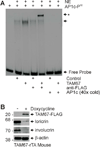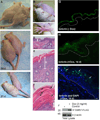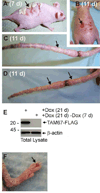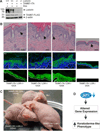Suppressing AP1 factor signaling in the suprabasal epidermis produces a keratoderma phenotype
- PMID: 25050598
- PMCID: PMC4268309
- DOI: 10.1038/jid.2014.310
Suppressing AP1 factor signaling in the suprabasal epidermis produces a keratoderma phenotype
Erratum in
-
Erratum.J Invest Dermatol. 2021 Jul;141(7):1862. doi: 10.1016/j.jid.2021.05.008. J Invest Dermatol. 2021. PMID: 34167723 No abstract available.
Abstract
Keratodermas comprise a heterogeneous group of highly debilitating and painful disorders characterized by thickening of the skin with marked hyperkeratosis. Some of these diseases are caused by genetic mutation, whereas other forms are acquired in response to environmental factors. Our understanding of signaling changes that underlie these diseases is limited. In the present study, we describe a keratoderma phenotype in mice in response to suprabasal epidermis-specific inhibition of activator protein 1 transcription factor signaling. These mice develop a severe phenotype characterized by hyperplasia, hyperkeratosis, parakeratosis, and impaired epidermal barrier function. The skin is scaled, constricting bands encircle the tail and digits, the footpads are thickened and scaled, and loricrin staining is markedly reduced in the cornified layers and increased in the nucleus. Features of this phenotype, including nuclear loricrin localization and pseudoainhum (autoamputation), are characteristic of the Vohwinkel syndrome. We confirm that the phenotype develops in a loricrin-null genetic background, indicating that suppressed suprabasal AP1 factor function is sufficient to drive this disease. We also show that the phenotype regresses when suprabasal AP1 factor signaling is restored. Our findings suggest that suppression of AP1 factor signaling in the suprabasal epidermis is a key event in the pathogenesis of keratoderma.
Conflict of interest statement
The authors have no conflict of interest financial or otherwise.
Figures






Comment in
-
Findings of Research Misconduct.Fed Regist. 2024 Aug 15;89(158):66420-66422. Fed Regist. 2024. PMID: 39161428 Free PMC article. No abstract available.
References
-
- Adhikary G, Crish J, Lass J, et al. Regulation of involucrin expression in normal human corneal epithelial cells: a role for activator protein one. Invest Ophthalmol Vis Sci. 2004;45:1080–1087. - PubMed
-
- Adhikary G, Crish JF, Gopalakrishnan R, et al. Involucrin expression in the corneal epithelium: an essential role for Sp1 transcription factors. Invest Ophthalmol Vis Sci. 2005;46:3109–3120. - PubMed
-
- Armstrong DK, McKenna KE, Hughes AE. A novel insertional mutation in loricrin in Vohwinkel's Keratoderma. J Invest Dermatol. 1998;111:702–704. - PubMed
-
- Brown PH, Chen TK, Birrer MJ. Mechanism of action of a dominant-negative mutant of c-Jun. Oncogene. 1994;9:791–799. - PubMed
Publication types
MeSH terms
Substances
Supplementary concepts
Grants and funding
LinkOut - more resources
Full Text Sources
Other Literature Sources
Molecular Biology Databases
Research Materials

